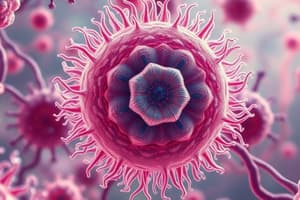Podcast
Questions and Answers
What is the primary distinction between prokaryotic and eukaryotic cells?
What is the primary distinction between prokaryotic and eukaryotic cells?
- Eukaryotic cells have a nuclear membrane. (correct)
- Eukaryotic cells lack organelles. (correct)
- Prokaryotic cells have a defined nucleus.
- Prokaryotic cells are larger than eukaryotic cells.
Who was the first to use the term 'cell' in microscopy?
Who was the first to use the term 'cell' in microscopy?
- Theodor Schwann
- Robert Hooke (correct)
- Antoine Van Leeuwenhoek
- Robert Brown
Which statement is a component of the cell theory?
Which statement is a component of the cell theory?
- All organisms are made of cells. (correct)
- All cells can perform photosynthesis.
- Cells are the only unit that can reproduce independently.
- All cells are prokaryotic in nature.
What did Mathias Schleiden conclude about plant cells?
What did Mathias Schleiden conclude about plant cells?
How does cell size vary among different organisms?
How does cell size vary among different organisms?
What was a significant advancement that contributed to the study of cytology?
What was a significant advancement that contributed to the study of cytology?
Which scientist discovered the nucleus within a cell?
Which scientist discovered the nucleus within a cell?
What unique characteristic do cells have to increase their efficiency?
What unique characteristic do cells have to increase their efficiency?
Flashcards are hidden until you start studying
Study Notes
Introduction to Cells
- The cell is the basic unit of all living organisms.
- There are two types of cells: prokaryotic and eukaryotic.
Characteristics of Cells
- Prokaryotic cells lack a nuclear membrane and membranous organelles.
- Eukaryotic cells have a clear nucleus surrounded by a nuclear membrane and cell organelles, and are typically larger than prokaryotic cells.
History of Cell Study
- The invention of the microscope by Antoine Van Leeuwenhoek (1632-1723) allowed for the discovery of cells.
- Robert Hooke (1635-1703) was the first to use the term "cell" when describing the structure of oak tree cortex.
- Robert Brown (1831) discovered the nucleus of the cell.
- Mathias Schleiden (1838) concluded that all plants are composed of cells.
- Theodor Schwann (1839) concluded that all animals are composed of cells.
Cell Theory
- The cell theory is based on the work of Schleiden and Schwann.
- Cells are the basic structural and functional units of all living organisms.
- Cells arise from pre-existing cells through cell division.
Cell Size and Function
- Cell size varies, with the diameter of a frog's egg being 1 mm (visible to the naked eye).
- Most cells are smaller than 1 mm, with human eggs being around 100 micrometers or less.
- Cells have specialized structures to increase the efficiency of various functions.
Studying That Suits You
Use AI to generate personalized quizzes and flashcards to suit your learning preferences.




